7 Loading Images
This chapter shows you how to change the application to upload a JPEG image for new employee records and display it on the Employees page. It has the following topics:
Using BLOBs to Store and Load Employee Images
In this section, you will modify your application code to enable a photo to be stored in the record of an employee.
To enable images of employees to be stored in the employee records, perform the following tasks:
-
Create the
chap7directory, copy the application files fromchap6, and change to the newly created directory:On Windows:
mkdir c:\program files\Apache Group\Apache2\htdocs\chap7 cd c:\program files\Apache Group\Apache2\htdocs\chap7 copy ..\chap6\* .
On Linux:
mkdir $HOME/public_html/chap7 cd $HOME/public_html/chap7 cp ../chap6/* .
-
Open SQL Developer and open a connection to your HR sample schema.
-
Login to your HR sample schema as hr.
-
Open SQL Worksheet and enter the following
CREATE TABLEstatement to create a new table for storing employee images:CREATE TABLE employee_photos( employee_id NUMBER, employee_thumbnail BLOB);
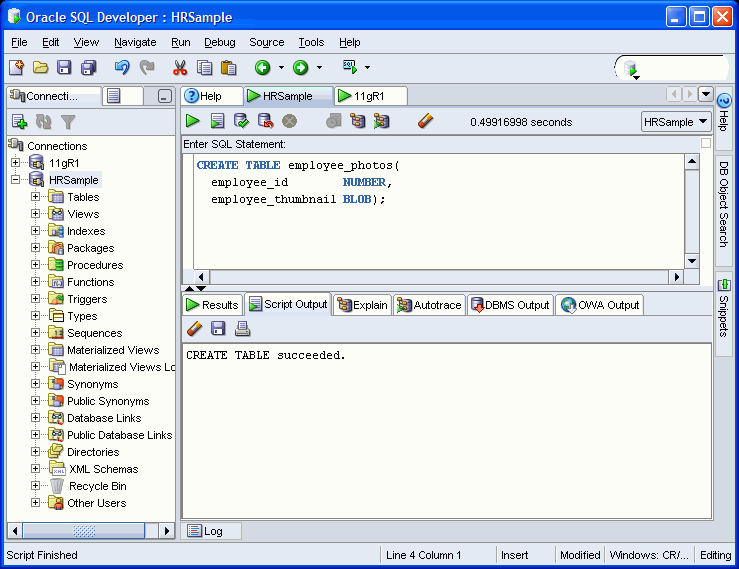
Description of the illustration chap7_hrcreatetable.gif
-
The
HRuser must have theCREATE TABLEprivilege to perform this command. If you get an "insufficient privileges" error message, then log out as theHRuser, log in assystem, and execute the followingGRANTcommand:GRANT create table TO hr;
Then log in as
HRagain to execute theCREATE TABLEstatement. -
Edit the
anyco_ui.incfile. Add a Photograph column to theEMPLOYEEStable in theui_print_employees()function:<th>Commission<br>(%)</th> <th>Remuneration</th> <th>Photograph</th>The data for the Photograph column is populated with an
<img>tag whosesrcattribute is defined as a URL reference to a newanyco_im.phpfile, which will display the image for each employee record. -
Edit the
anyco_ui.incfile. Add code in theui_print_employees()function to generate an<img>tag referencing theanyco_im.phpfile with the employee identifier as a parameter:echo '<td align="right">' .htmlentities($emp['REMUNERATION']).'</td>'; echo '<td><img src="anyco_im.php?showempphoto='.$emp['EMPLOYEE_ID'] .'" alt="Employee photo"></td>'; -
Edit the
anyco_ui.incfile. To enable images to be uploaded when a new employee record is created, add anenctypeattribute to the<form>tag in theui_print_insert_employee()function:<form method="post" action="$posturl" enctype="multipart/form-data">At the bottom of the form add an upload field with an input type of
file:<tr> <td>Commission (%)</td> <td><input type="text" name="commpct" value="0" size="20"></td> </tr> <tr> <td>Photo</td> <td><input type="file" name="empphoto"></td> </tr>
-
Create the
anyco_im.php file.This file accepts an employee identifier as a URL parameter, reads the image from the Photograph column for that employee record, and returns the thumbnail image to be displayed:<?php // anyco_im.php require('anyco_cn.inc'); require('anyco_db.inc'); construct_image(); function construct_image() { if (!isset($_GET['showempphoto'])) { return; } $empid = $_GET['showempphoto']; $conn = db_connect($err); if (!$conn) { return; } $query = 'SELECT employee_thumbnail FROM employee_photos WHERE employee_id = :eid'; $stid = oci_parse($conn, $query); $r = oci_bind_by_name($stid, ":eid", $empid, -1); if (!$r) { return; } $r = oci_execute($stid, OCI_DEFAULT); if (!$r) { return; } $arr = oci_fetch_row($stid); if (!$arr) { return; // photo not found } $result = $arr[0]->load(); // If any text (or whitespace!) is printed before this header is sent, // the text is not displayed. The image also is not displayed properly. // Comment out the "header" line to see the text and debug. header("Content-type: image/JPEG"); echo $result; } ?>
The
construct_image()function uses theOCI-Lob->load()function to retrieve the Oracle LOB data, which is the image data. The PHPheader()function sets the MIME type in the HTTP response header to ensure the browser interprets the data as a JPEG image.If you want to display other image types, then the
Content-typeneeds to be changed accordingly. -
Edit the
anyco_db.incfile. Add a new functiondb_insert_thumbnail()to insert an image into theEMPLOYEE_PHOTOStable:function db_insert_thumbnail($conn, $empid, $imgfile, &$e) { $lob = oci_new_descriptor($conn, OCI_D_LOB); if (!$lob) { $e = db_error($conn, __FILE__, __LINE__); return false; } $insstmt = 'INSERT INTO employee_photos (employee_id, employee_thumbnail) VALUES(:eid, empty_blob()) RETURNING employee_thumbnail into :etn'; $stmt = oci_parse($conn, $insstmt); $r = oci_bind_by_name($stmt, ':etn', $lob, -1, OCI_B_BLOB); if (!$r) { $e = db_error($stid, __FILE__, __LINE__); return false; } $r = oci_bind_by_name($stmt, ':eid', $empid, -1); if (!$r) { $e = db_error($stid, __FILE__, __LINE__); return false; } $r = oci_execute($stmt, OCI_DEFAULT); if (!$r) { $e = db_error($stid, __FILE__, __LINE__); return false; } if (!$lob->savefile($imgfile)) { $e = db_error($stid, __FILE__, __LINE__); return false; } $lob->free(); return true; }
To tie the new
EMPLOYEE_PHOTOSandEMPLOYEEStables together, you must use the same employee id in both tables. -
Edit the
anyco_db.incfile. Change the$bindvarsparameter in thedb_execute_statement()function to&$bindvarsso thatOUTbind variable values are returned from the database. At the bottom of the function, add a loop to set any return bind values:function db_execute_statement($conn, $statement, &$e, &$bindvars = array()) { ... $r = @oci_execute($stid); if (!$r) { $e = db_error($stid, __FILE__, __LINE__); return false; } $outbinds = array(); foreach ($bindvars as $b) { $outbinds[$b[0]] = $$b[0]; } $bindvars = $outbinds; return true; }
-
Edit the
anyco.phpfile. Change the INSERT statement in theinsert_new_emp()function so that it returns the new employee identifier in the bind variable:neweid. This value is inserted with the image into the newEMPLOYEE_PHOTOStable.$statement = 'INSERT INTO employees (employee_id, first_name, last_name, email, hire_date, job_id, salary, commission_pct, department_id) VALUES (employees_seq.nextval, :fnm, :lnm, :eml, :hdt, :jid, :sal, :cpt, :did) RETURNING employee_id into :neweid';Also in the
insert_new_emp()function, add a call to thearray_push()function to set a new bind variableNEWEIDat the end of the list ofarray_push()calls:array_push($bindargs, array('CPT', $newemp['commpct'], -1)); array_push($bindargs, array('DID', $newemp['deptid'], -1)); array_push($bindargs, array('NEWEID', null, 10));Because the value of
NEWIDis being retrieved with the RETURNING clause in the INSERT statement, its initial value is set toNULL. The length is set to 10 to allow enough digits in the return value. -
Edit the
anyco.phpfile. In theinsert_new_emp()function, add a call between thedb_execute_statement()andconstruct_employees()calls to insert the thumbnail image:$r = db_execute_statement($conn, $statement, $err, $bindargs); if ($r) { $r = db_insert_thumbnail($conn, $bindargs['NEWEID'], $_FILES['empphoto']['tmp_name'], $e); construct_employees(); } -
In a browser, enter the following application URL:
On Windows:
http://localhost/chap7/anyco.php
On Linux:
http://localhost/~<username>/chap7/anyco.php
-
In the Departments page, click Show Employees to navigate to the Employees page:
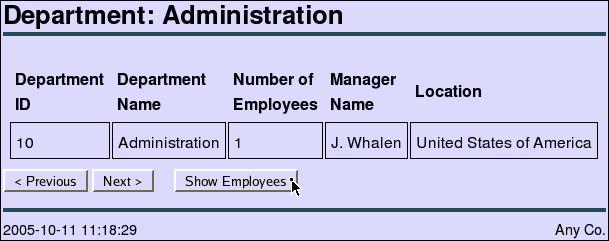
Description of the illustration chap7_loadimg_005.gif
-
In the Employees page, to insert a new employee record click Insert new employee:
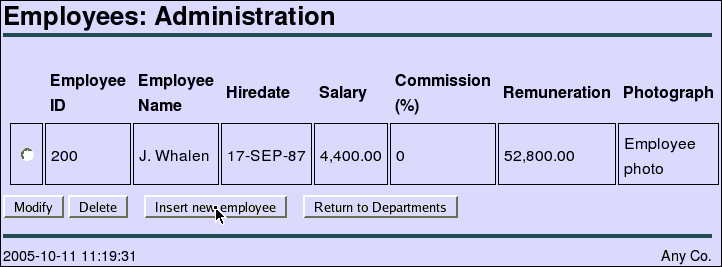
Description of the illustration chap7_loadimg_006.gif
-
The Insert New Employee form allows you to choose a thumbnail image on your system to be uploaded to the database. Enter your own values in the fields or use the values as shown. Click Browse:
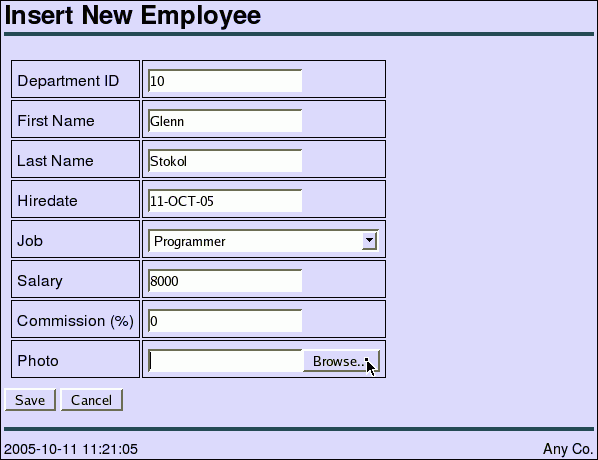
Description of the illustration chap7_loadimg_007.gif
-
In the File Upload window, browse for and select a JPEG image file, and click Open:
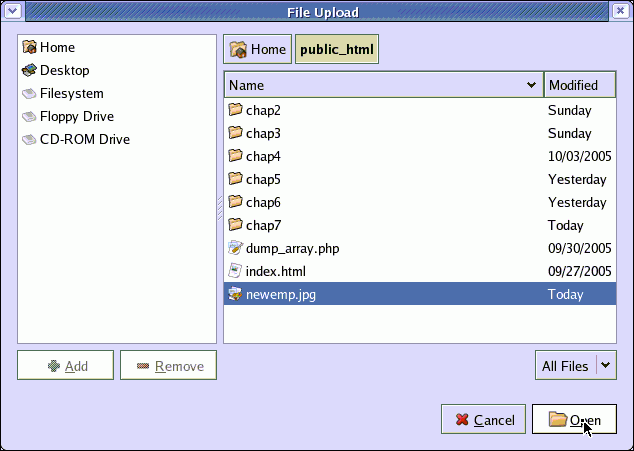
Description of the illustration chap7_loadimg_008.gif
-
In the Insert New Employee page, click Save:
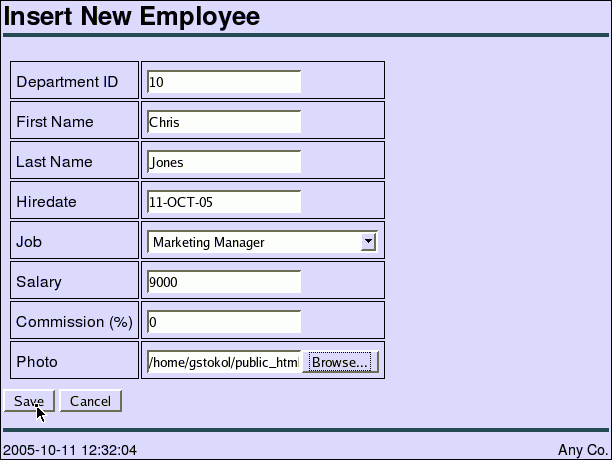
Description of the illustration chap7_loadimg_022.gif
The Employees page is displayed with the new employee record, including the image, which is displayed at its original size:
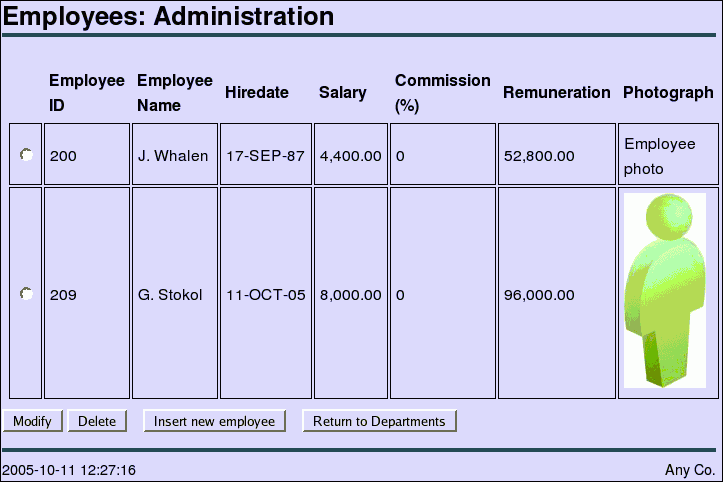
Description of the illustration chap7_loadimg_009.gif
Resizing Images
In this section, you will further modify your application code to create a thumbnail image from a supplied image, and store the thumbnail image in the record of an employee.
You can use the PHP GD graphics extension to resize employee images.
-
Restart Apache. You can either use the ApacheMonitor utility, or you can use Windows Services.
To use the ApacheMonitor utility, navigate to the Apache
bindirectory and double clickApacheMonitor.exe. In a default installation, Apachebinis located atc:\Program Files\Apache Group\Apache2\bin.You can access Windows Services from the Windows Start menu at Start > Control Panel > Administrative Tools > Services. Select the Standard tab. Right click the Apache2 HTTP Server and then select Restart.
-
Edit the
anyco_db.incfile. To resize the image to create a thumbnail image, add the following code before the call to$lob->savefile($imgfile)in thedb_insert_thumbnail()function:$r = oci_execute($stmt, OCI_DEFAULT); if (!$r) { $e = db_error($stid, __FILE__, __LINE__); return false; } // Resize the image to a thumbnail define('MAX_THUMBNAIL_DIMENSION', 100); $src_img = imagecreatefromjpeg($imgfile); list($w, $h) = getimagesize($imgfile); if ($w > MAX_THUMBNAIL_DIMENSION || $h > MAX_THUMBNAIL_DIMENSION) { $scale = MAX_THUMBNAIL_DIMENSION / (($h > $w) ? $h : $w); $nw = $w * $scale; $nh = $h * $scale; $dest_img = imagecreatetruecolor($nw, $nh); imagecopyresampled($dest_img, $src_img, 0, 0, 0, 0, $nw, $nh, $w, $h); imagejpeg($dest_img, $imgfile); // overwrite file with new thumbnail imagedestroy($src_img); imagedestroy($dest_img); } if (!$lob->savefile($imgfile)) { ...The
imagecreatefromjpeg()function reads the JPEG file and creates an internal representation used by subsequent GD functions. Next, new dimensions are calculated with the longest side no larger than 100 pixels. A template image with the new size is created using theimagecreatetruecolor()function. Data from the original image is sampled into it with theimagecopyresampled()function to create the thumbnail image. The thumbnail image is written back to the original file and the internal representations of the images are freed.The existing code in the
db_insert_thumbnail()function uploads the image file to the database as it did in the previous implementation. -
Enter the following URL in your browser to test the changes in your application:
On Windows:
http://localhost/chap7/anyco.php
On Linux:
http://localhost/~<username>/chap7/anyco.php
-
In the Departments page, navigate to the Employees page by clicking Show Employees:
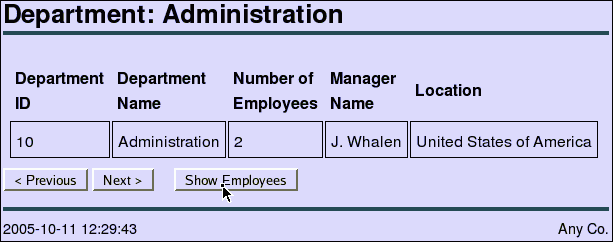
Description of the illustration chap7_loadimg_018.gif
-
In the Employees page, to insert a new employee record, click Insert new employee:
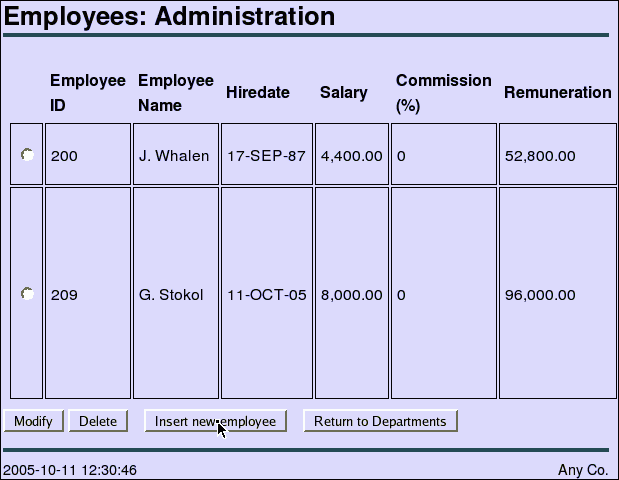
Description of the illustration chap7_loadimg_019.gif
-
Enter the new employee details or use the values shown. To browse for an employee image, click Browse:
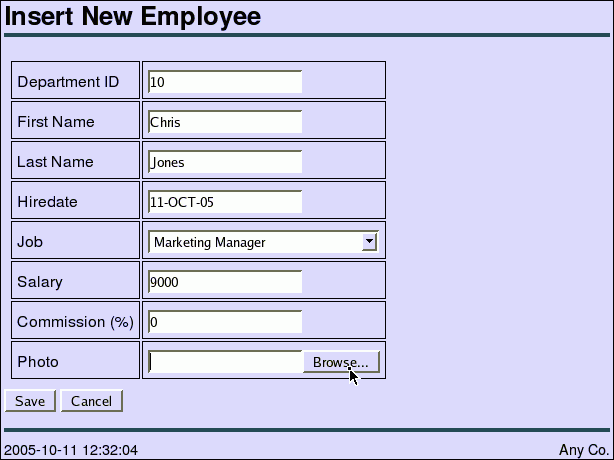
Description of the illustration chap7_loadimg_020.gif
-
Locate and select a JPEG image with a size larger than 100 pixels, and click Open:
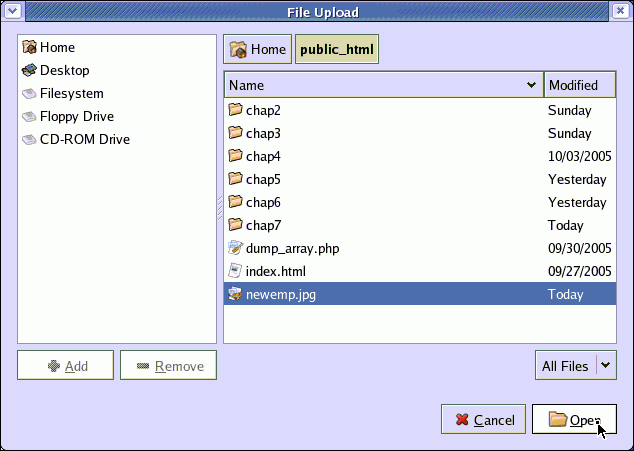
Description of the illustration chap7_loadimg_021.gif
-
In the Insert New Image page, click Save:

Description of the illustration chap7_loadimg_022.gif
The Employees page shows the new uploaded JPEG image with a reduced image size, compared to the image loaded before including the image resize code:
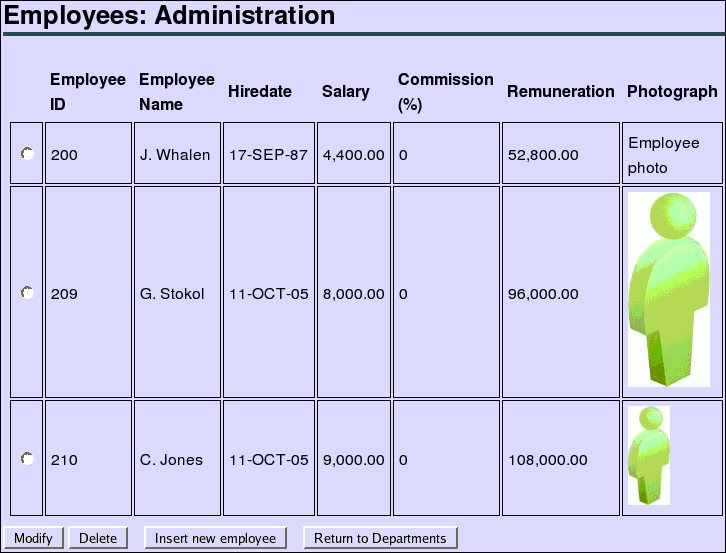
Description of the illustration chap7_loadimg_023.gif